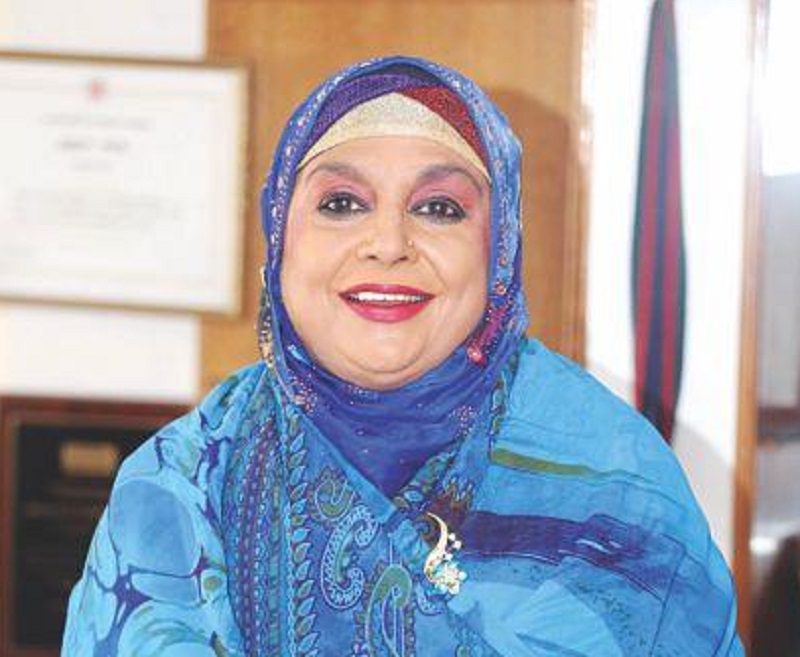
Since the news of sad demise of Sohni Dharti Allah Rakhay famed Shahnaz Begum was aired by Bangladesh Television, Dispatch News Desk (DND) News Agency started to find someone who could give first-hand knowledge about the life of late Shahnaz Rahmatullah (formerly known as Shahnaz Begum in Pakistan).
DND News Agency contributor from Dhaka also failed to find something special and something real about her. DND contacted Dr. Yasmeen Kazi Sahiba who is veteran for Pakistan and Bangladesh friendship and runs Pak Bangladesh Friendship Group at Facebook. Dr Yasmeen Kazi shared an excellent piece of writing published by Dhaka based “The Daily Star” and written by Nashid Kamal. Some parts of this article are being reproduced to share first-hand information about late Shahnaz Begum and her later years and gives insight how beautiful singer, how excellent wife, a dedicated mother and trust worthy friend she was who devoted her entire property for poor people in her life after Umrah she performed and then her transformation to a woman who forget everything around her and linked her soul only with All Mighty God—
Here is the article for our readers:
Shahnaz Rahmatullah (former maiden name Shahnaz Begum) has been close to my heart since my childhood. I grew up in Purana Paltan, Dhaka and she too lived there. Even before she could sing, she would visit us, i.e. my aunt Ferdausi Rahman with her mother who was ravishingly beautiful and very much into music. She was the driving force behind her talented children (her sons Anwar Pervez and Zafar Iqbal). Shahnaz was special always; taking part is a film song ‘CAT cat mane biral’, along with songstress Sabina Yasmin, Nilufer Yasmin, rehearsing in our house as a child artist accompanying Ferdausi Rahman in the 60s.
For me, she was a teenage idol, I watched her program next in Bangla Academy, she was a beautiful teenager, singing songs tuned by the maestro Abdul Latif. Her large dark eyes caught my fancy and continues to do so as she passed through her lifetime from that small girl I met as a child, to this lady of fame.
When I peeked in during my own children’s program, I found the producers busy at their desk, editing these songs Shongram shongram shongram, cholbe din rat obiram. Her modern songs like Khola janalay cheye dekhi, portrayed on TV with the open window and a gust of wind emerging to unsettle the long black hair, added ecstasy to my adolescent days. It was followed by other famous songs such as the one written by lyricist Jebunnesa Jamal, ‘Sagor er teer theke’.
Shahnaz started her playback for the movies, it would be the 70s. From distant houses of the post office building (adjacent to our house), I heard songs being played ‘Phuler kane bhromor’, ‘Holud bato, mendi bato, bato phuler mou’. After the liberation, she sang for Khan Ataur Rahman in the movie ‘Abartora Manushhou’, the epic song ‘Ek nodi rokto periye’ (1973). There was something in her voice, her perfect tune, her pronunciation, delivery and underlying thoughts which made even a simple song, so touching, so heart rendering, so inimitable.
During the interim period, she had gone to perform in erstwhile West Pakistan to release her brother Zafar Iqbal (from jail) and caught the eye of the audience there. She had a solo show on Karachi TV where she was all dressed up by the fashion icons and presented each episode with glittery accurateness. Shahnaz’s rendering of the patriotic song ‘Sohni Dharti Allah rakkhe’ was a milestone. None would let her go. I was witness to her immense popularity in Pakistan when I travelled with her later in 1997 to celebrate the 50 years of Radio Pakistan in Islamabad. The audience simply would not leave her without this song, and interestingly enough, her popularity among Bangladeshis is another dimension to be a witness of. I was lucky to have a glimpse of that too in 1989, we travelled together to Japan, Shahnaz Rahmatullah helped me look after my daughter Aashna, who was only two and half years old. A loving mother as is Shahnaz, the audience would not let her go without all her beautiful songs, which grew over the years and Alauddin Ali’s tune for the cassette ‘Je chilo drishtir shimanay’ stood highest in its claim to popularity. As she left the stage on 26th March 1989 (in Tokyo) without singing Ek nodi rokto periye, she was called back on stage and when she sang, the audience joined. In this article I celebrate her feat at being the darling patriotic song singer of two nations! What an achievement!
As I met her last week at a quiet lunch in her home, all these thoughts were bubbling inside my head, when Shahnaz explained how she went for Umrah with her husband Mr. Rahmatullah and felt a change in her as she touched the Kaaba (2010). She felt a need to dedicate herself toGod, help the poor and turn to a care giver. She sold her properties and gave them away to the poor, her two children are settled in their own ways, says she. Now she spends her time in God’s pursuit, reading the suras and prayers until the dead of night and waking up at Tahajjud and praying again has been her special joy. What she has given in the form of art is a joy to the aesthetic sense in a different way and what she is giving now in a spiritual sense is another way of calling God, the creator. Reminds me of a title of my Uncle Abbasi’s book, ‘Je namei dako’ (whatever name you propose to call God). Let her prayers be answered.
